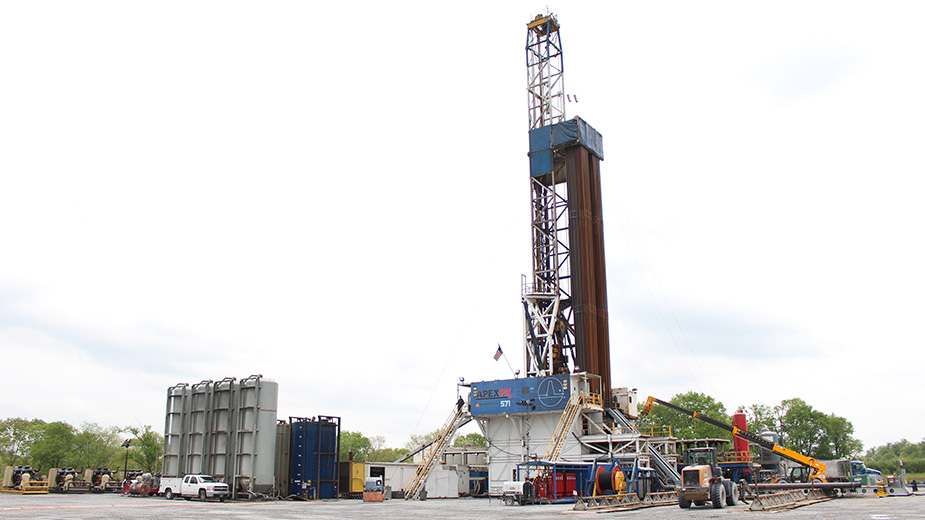Blue Racer Shelves Petersburg Gas Project
PITTSBURGH — Blue Racer Midstream LLC has shelved plans to construct a multimillion-dollar natural gas processor in southeastern Mahoning County, one of the company’s top executives said Thursday.
“I wouldn’t say it’s out of the question at some point in the future, but it certainly is at this particular point in time,” remarked Scott Williams, executive vice president and chief commercial officer for Blue Racer.
Williams was among a host of speakers who addressed the Hart Energy Marcellus-Utica Midstream Conference here yesterday.
Initially, Blue Racer laid out plans to construct a midstream network that included expansions of its existing processing plant in Natrium, W.Va., and the construction of three additional cryogenic plants in Berne, Lewis and Petersburg in Ohio.
Williams said that its Berne cryogenic plan in Monroe County, Ohio, is operational and that Blue Racer expects to add a capacity of 200 million cubic feet per day. Plans to construct another processing plant in Lewis in Harrison County are also moving forward.
However, Blue Racer — a $1.5 billion joint venture between Dominion and Caiman Energy II — has pulled back from the Petersburg project in the northern tier of the Utica, an area Williams confirms hasn’t yet delivered sufficient oil and gas production.
“The results up there haven’t been really all that good,” Williams said. “We really thought that was going to be one of the hot parts of the play and it hasn’t panned out yet.”
Cryogenic plants accept natural gas transported via gathering pipelines from well sites. The plants chill the gas to a point where dry gas such as methane separates from heavier, wet gas. The methane is pumped into traditional dry gas lines while the wet gas is shipped through pipelines to be converted into specific products such as ethane, butane and propane.
Citing poor well results, BP America pulled its operations out of the northern Utica last year. Halcon Resources suspended its drilling program in the north for the same reasons.
“We have the Petersburg location, but we don’t have any plans right now for Petersburg,” he said.
Hilcorp Energy Co., the most active driller in the northern tier, especially in western Pennsylvania, partnered with NiSource Midstream and constructed its own processing plant in Springfield Township in Mahoning County. Last year Hilcorp invested $400 million in its Utica drilling operations (READ STORY)
A map on Blue Racer’s website that once showed a plant to be built in Petersburg has since been removed and replaced with another map without the site marked.
The situation is different in the southern portion of Ohio’s Utica, where the bulk of exploration is concentrated. Here, particularly in Monroe, Belmont and Noble counties, wells are producing some staggering numbers that rival some of the best Marcellus shale wells in Pennsylvania.
“Once the Utica started producing and we saw the results of some of the wells, we knew we were on to something big,” Williams said.
Overall, Ohio is a leader in oil and gas growth throughout the country, Williams said, noting that 275,000 conventional and unconventional wells have been drilled across the state throughout its history, ranking it fourth behind Texas, Oklahoma and Pennsylvania.
Blue Racer holds 647 miles of gathering pipeline throughout Ohio, the capacity to process 600 million cubic feet of gas per day and the ability to fractionate 47,000 barrels of wet gas at its plant in Natrium, Williams said.
“We are continuing to grow,” he continued. The Berne plant, for example, plans to add processing capacity of another 200 million cubic feet per day in the spring, bringing total daily capacity at that plant to 800 million cubic feet.
Producers have slowed exploration efforts in the Utica and other shale plays since oil and gas prices started their slide last summer. Natural gas liquids are flooding the market as well, Williams said, citing an estimate of 1.1 million barrels produced by 2020.
That means additional infrastructure is necessary for ethane and natural gas liquids takeaway, he said. “We think processing can stay in front of production curve for a number of years.”
He estimated more than 200 wells have been drilled or are being drilled that await pipeline hookups. “We’re fortunate at Blue Racer that half of those are on acreage dedicated to our facilities,” he said.
As it stands, the infrastructure is inadequate to handle the production potential of the Utica. Williams added, “We think there’s in excess of $30 billion that still needs to be spent up here.”
As pipeline networks fall into place, other companies are finding success in transporting condensate from Utica wells via barges to refineries along the Ohio River.
For example, Marathon Pipe Line LLC is now loading its condensate onto barges at the Intermodal Facility just outside Wellsville in Columbiana County, said its president, Craig Pierson, who attended the Hart Energy conference.
“We’ve got a connection agreement with another company that’s right beside our Wellsville facility, and they’ve got a 10-lane condensate truck unloading facility, we have a two-lane unloading facility,” Pierson said.
The company aggregates the condensate into a holding tank. The product is then shipped through a pipeline to Marathon’s dock where it’s loaded on barges for shipment down the Ohio River.
“Right now, it’s currently bound for our refinery in Catlettsburg, Ky.,” he said. “We’re available for other service as well.”
The Catlettsburg refinery produces motor fuels such as gasoline and diesel products, and Pierson expects the Wellsville Utica operation to grow.
“We are ready for it to grow and anticipate it will grow,” Pierson said. “We’re looking for future increase in production. “We’ve got a great opportunity to lay some pipelines to help connect supply and demand in Ohio and move Utica production to consumers. We’re excited about the Utica play.”
Copyright 2015 The Business Journal, Youngstown, Ohio.
Copyright 2024 The Business Journal, Youngstown, Ohio.


